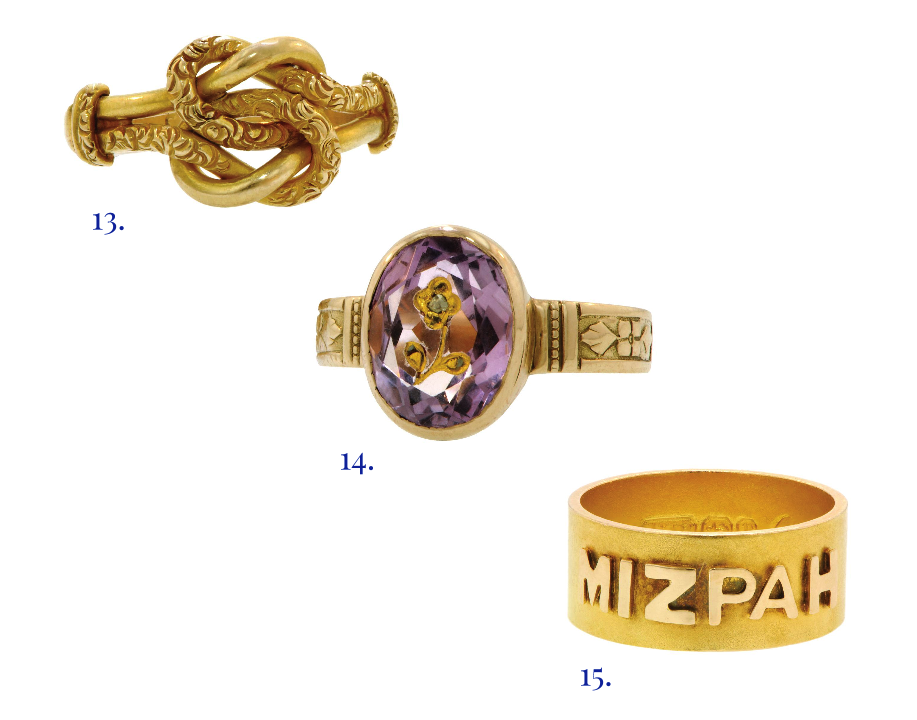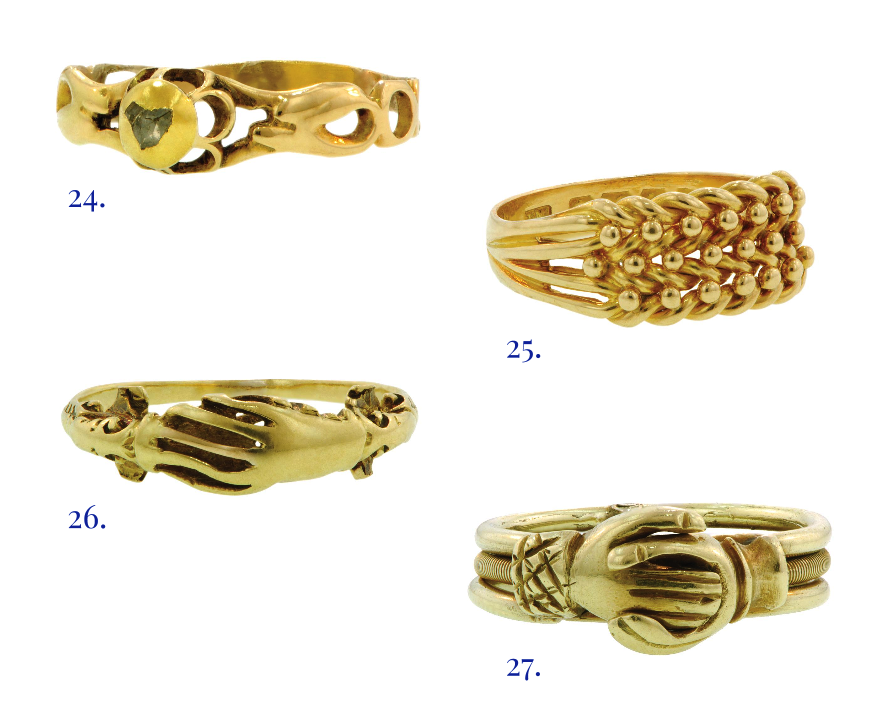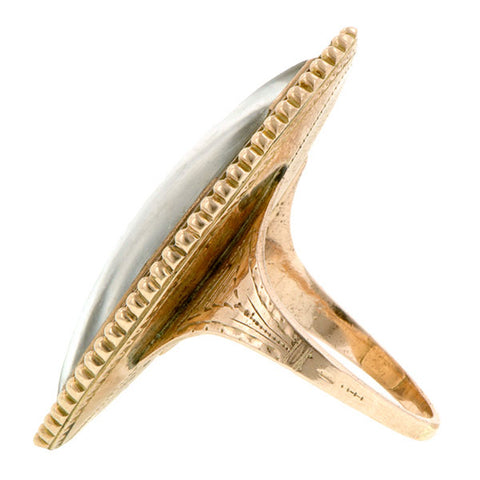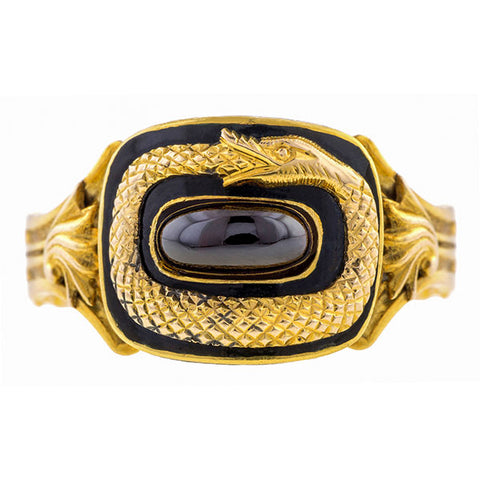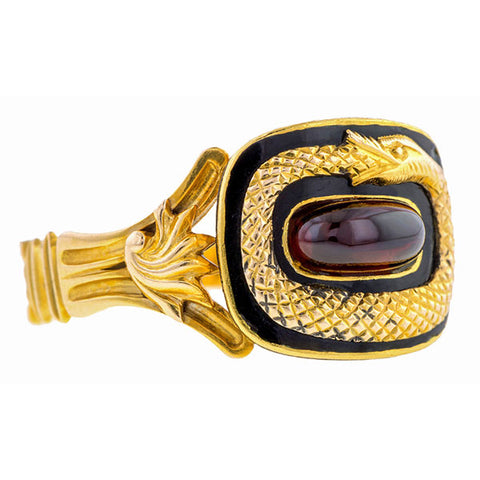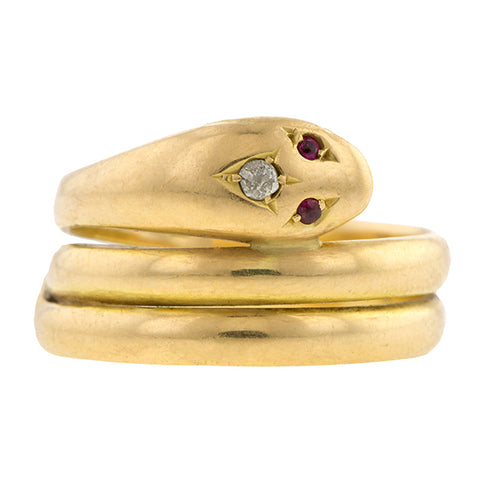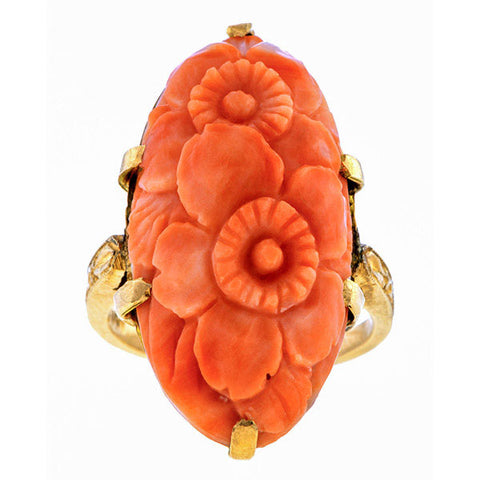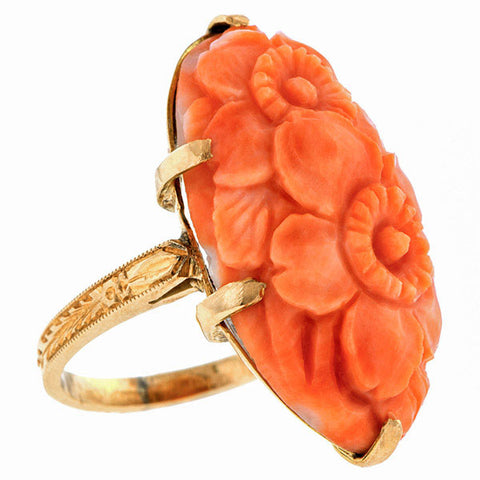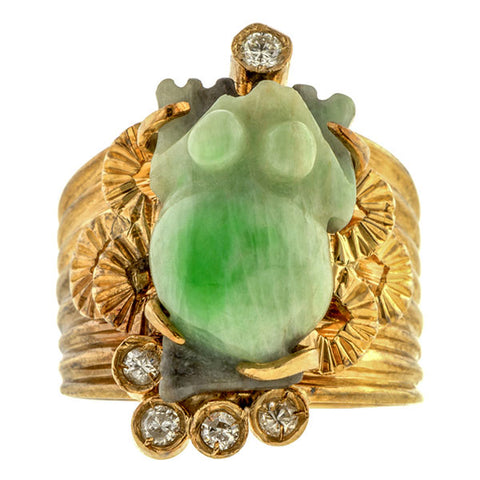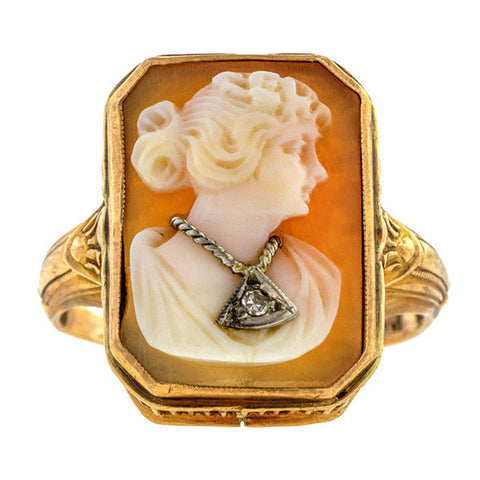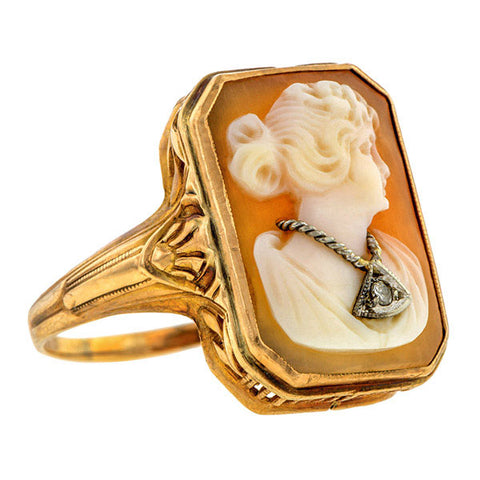Categories
Categories
Since Doyle & Doyle’s founding in 1998 by sisters Elizabeth and Irene Pamela Doyle, they’ve showcased a beautifully curated selection of vintage, antique, and estate jewelry. Led by the Doyles’ love of history and design, Doyle & Doyle also serves as a resource for the community to discover the rich history of jewelry and personal adornment. In this tradition, we are excited to introduce The Vault, an ongoing series of exhibitions of curated collections around a theme.
For the second Vault exhibition, Elizabeth selected a topic close to our hearts: rings. The reasons people exchange rings, and the feelings they evoke, inspired “Sentimental Rings: From Birth to Death and In-Between.” Elizabeth’s co-curator is none other than the ring queen herself, Danielle Miele of Gem Gossip. Danielle’s love affair with rings is well documented in her “Show Me Your Rings” series, where she invites readers and fellow jewelry lovers to submit photos of their favorite collections. We’re excited to share a selection of her treasured pieces, alongside rings from Elizabeth Doyle, Doyle & Doyle, and other private collections.
While most of the pieces included in “Sentimental Rings” are from private collections and not for sale, click here to shop our fabulous selection of antique & vintage rings. Doyle & Doyle rings included in the exhibition will be available for purchase after “Sentimental Rings” ends on November 9.
The rings in “Sentimental Rings: Birth to Death and In-Between” comprise five themes:
Birth & Childhood: Commemorating the birth of a child or significant event in childhood.
Memento: A souvenir of a special event, time or place.
Love Token: A gift of friendship, remembrance or romantic love between two people.
Courting & Marriage: Stating an intention of love, betrothal and commitment.
Death & Mourning: Honoring and remembering the departed and revering mortality.
1. Baby Tooth Ring – gold, sapphire, diamond, and baby tooth. English. Centering a baby tooth framed by sapphires and rose cut diamonds. Circa 1890. Courtesy of Doyle & Doyle Baby, or milk tooth rings were made to commemorate a developmental milestone in a child’s life, the loss of their first tooth. This feat was not one to be taken for granted in the Victorian Era with infant mortality soaring to over 50% in parts of England. Tooth jewels were not limited to just rings. In fact milk teeth were set in many types of jewels. Perhaps the best known example of a milk tooth jewel is the Thistle Brooch that Prince Albert presented to Queen Victoria. When their eldest daughter, Princess Vicky, lost her first tooth, Prince Albert commissioned a gold and enamel thistle brooch with the milk tooth representing the flower. The Queen had many pieces of jewelry made from her children’s teeth, and the style became a popular sentimental trend.
Baby rings were all the rage in Victorian times; set with tiny diamonds and stones or engraved with a monogram, floral pattern or other simple design, it was not unusual to have matching bands for a mother and child.
2. Baby Ring – gold and diamond. Wide band inset with a rose cut diamond. Circa 1900. Courtesy of Doyle & Doyle The rose cut diamond, or “spark” as it was known at the time, was a fitting choice for a child’s ring as a symbol of the spark or beginning of something greater. This sentiment is expressed in a 17th century child’s gold ring set with a rose cut diamond housed at the Victoria & Albert Museum in London. It bears the inscription “This Spark Will Grow.” A charming sentiment that remained popular through the 19th century, appealing to the Victorian’s love of hidden meanings and double entendres.
3. Baby Ring – gold and blue stone. Three stone ring in tapered design with beaded border. Circa 1900. Courtesy of Doyle & Doyle Victorians loved symbolism and meaning behind stones. Birthstones, commemorating the month of birth, were no exception. The blue stones in this child’s ring represent sapphires, the birthstone for September.
4. Baby Ring – gold. Slim band with orange blossom pattern. Circa 1900. Courtesy of Doyle & Doyle This ring features the orange blossom pattern, a very popular design on wedding bands in the late Victorian era and remaining so through the middle of the 20th century. Orange blossoms symbolized fertility or fruitfulness. Queen Victoria wore the blossoms in her hair for her wedding to Prince Albert in 1840, starting a fashionable trend amongst Victorian brides. This miniaturized version of an orange blossom wedding band was likely made as a child’s version of her mother’s wedding band.
5. Intaglio Hercules Ring – gold and amethyst. Featuring a deeply carved, oval amethyst intaglio of Hercules, very similar in appearance and pose to a cameo once in the possession of Pope Clement VII from the Marlborough Collection. Late 18th century. Courtesy of Doyle & Doyle This type of ring would have been collected on the Grand Tour; proving to be the ultimate souvenir of someone’s exciting journey through classical Europe. Often times the intaglio gem would be found on their travels and brought home to be set in a ring or other piece of jewelry. Sometimes a whole parure, or suite of jewelry, would be made from the intaglios, cameos, micro mosaics, or other gems procured.
6. 1910 Heart Ring – gold. Centering a monogrammed heart amidst the year 1910. 20th century. Courtesy of Doyle & Doyle Date rings were made to commemorate an event or important milestone such as a graduation, or serve as a souvenir from a world’s fair or even bringing in the New Year. Although we don’t know what the exact occasion was for this ring, the addition of the heart and inscription indicate it was a very personal memento.
7. Diamond Portrait/Mask Ring – gold, diamond, and enamel. Hand painted masked woman framed by rose cut diamonds. 20th century. Courtesy of Danielle Miele Masquerade rings, first created in the 18th century, were a popular item for the fun-loving Georgians of the period, who attended these types of balls wearing masks, powdered wigs and even costumes. The 18th century represented the peak of frivolity and extravagance, and nothing was more extravagant than a masquerade ball, especially if it was a costume ball. A masquerade ring epitomized the novelty of these grand events and provided the wearer with a nostalgic link to their special time at the ball. Our ring from the late 19th century, with some 20th century alterations, is a revival ring of sorts, harkening back to the masquerade balls of the late 18th and early 19th centuries.
8. Regard Ring – gold, ruby, emerald, garnet, amethyst, and diamond. English. Bezel and prong set stones in a twisted wire frame with scrolled shoulders. Circa 1870. Courtesy of Doyle & Doyle Becoming a fad in the Georgian era and only increasing in popularity during Victorian times, acrostic jewelry was the secret language of stones found in love tokens. A romantic word or phrase was spelled out by using the first letter of a particular gemstone, as in this ring: Ruby, Emerald, Garnet, Amethyst, Ruby, Diamond = REGARD. Other common sentiments include: Diamond, Emerald, Amethyst, Ruby, Emerald, Sapphire, Topaz = DEAREST & Amethyst, Diamond, Opal, Ruby, Emerald = ADORE
Poesy or Posy, coming from the French for poetry, poésie. First known in the medieval era and, at that time, usually written in French (being considered the language of love), the poesy ring was a popular token of love between romantic loves and also friends. Sentiments or poesies such as “When this you see remember me” or “A friend indeed in tyme of need”, or “I am your friend unto the end” might be a poesy for a friend, whereas, “Accept of this my heart withall – my love is great though this be small”, or “As God saw fitt our knott is knit”, or “I do rejoyce in thee my choice”, were poesies for courting and married couples.
9. Poesy Ring – gold. English. A wide band with double bead design between bosses, which simulate cabochon cut gems, in rope-like frames. The interior engraved with: “As true in love as turtle dove.” Circa 1680. Courtesy of Julia Rover
10. Poesy Ring – gold and enamel. English. A slim band with alternating engraved hearts and ovals with white enamel arrows in between. A few spots of colored enamel are still visible on this band. The interior engraved with: “I live in yoor love hold it so.” Circa 1650. Courtesy of Julia Rover
11. Poesy Ring – gold. English. A small, plain child’s band, possibly even a betrothal ring. The interior engraved with: “Thy·virtue·is·thy·honour” and an eight pointed star. Circa 1700. Courtesy of Julia Rover It was not uncommon for a young child to be betrothed, even at the age of 6, and possibly married by the age of 12.
12. Poesy Ring – gold. A plain band, engraved on the interior, “Vertue gaineth glory.” English. Circa 1700. Courtesy of Julia Rover
13. Double Lovers’ Knot Ring – gold. English. Gold ring fashioned into a pair of intertwined knots, one plain, one chased. Circa 1860. Courtesy of Doyle & Doyle The association of knots with the symbolism of love, friendship, and affection dates back to antiquity. Clifford Warren Ashley (1881 –1947) an American artist, author, sailor, and knot expert notes – “… it was once common for sailors’ wedding rings, where gold wire was wrought to incorporate the ‘true lovers’ knot such that resultant ring would comprise two tori: each flexible to move about the other; yet nevertheless inseparable.”
14. Forget-Me-Not Ring – gold, amethyst, and diamond. An oval amethyst inset with gold forget-me-not flower and rose cut diamond with engraved band. 1876. Courtesy of Doyle & Doyle The forget-me-not flower, a common sentimental motif for the Victorians, symbolized true love and remember me always. The inscription on this ring is lovingly worn on the inside of the band with only a partial date left discernible, “-25-76,” for 1876. With the date of “25,” one wonders if it might have been a gift of affection on Christmas day in 1876.
15. Mizpah Band – gold. Coley Brothers – Birmingham, England. Wide plain band with raised letters spelling: MIZPAH. Interior engraved, “Oct. 1900 – JLJ to LM.” 1898. Courtesy of Doyle & Doyle Mizpah, a Hebrew word, referenced in the Bible, Genesis 31:49, “And Mizpah; He said, The Lord watch between thee and me when we are apart.” The word mizpah came to symbolize a love or bond between two people during Victorian times. Mizpah jewelry was often exchanged between lovers or friends when separated for a long period of time and reached its zenith in popularity during World War I, when so many sweethearts were separated.
16. Friendship Ring – Gold, white enamel, foiled back paste, amethyst, and hair. English. A cluster style ring with amethyst frame centering a foil backed paste in the color of a rich garnet. The ribbon-like hoop or band with white enamel, featuring the phrase, “L’Amitie Sans Fin,” or “friendship without end.” On the reverse is a locket compartment with plaited hair and an M cipher of gold thread. Circa 1740. Courtesy of Julia Rover This is a rare example of a love token or friendship ring, with the white enamel signifying that the wearer was unmarried or virginal. Hair was commonly exchanged as a token of love, friendship and remembrance. Even today we may carry a lock of loved one’s hair in a locket or perhaps pressed among the pages of a letter, as a cherished possession.
17. Locket Back Ring – gold, emerald, and pearl. The locket compartment, now missing its rock crystal cover, would have contained a lock of a loved one’s hair, most likely in the form of a plait. Circa 1820. Courtesy of Doyle & Doyle
18. Locket Ring – gold. 20th century. Courtesy of Danielle Miele Following the long tradition of placing a lock of plaited hair, portrait or later, a photograph inside a jewel, this vintage example, with engraved locket, bears the photograph of Matthew LaBonte, the fiancé of co-curator, Danielle Miele.
19. Buckle Locket Ring – gold. The top of the band opens to reveal a secret compartment. Circa 1900. Courtesy of Doyle & Doyle These rings were designed to hold a plait of a loved one’s hair hidden inside. The buckled belt or garter, a symbol of true unending love, could have been worn by a family member, a friend or a romantic love.
20. Twin Heart Snake Ring – gold, ruby, and diamond. Ruby and diamond hearts set within a pair of coiled snakes. Circa 1880. Courtesy of Elizabeth Doyle A design that found its beginnings in the 18th century, twin heart rings are seen set with many different types of stones and topped with everything from arrows, bows, crowns and lover’s flames. This ring, with the ruby and diamond hearts set amidst entwined snakes, literally combines the symbolism of eternal love. The snake eating or biting its tail has been a symbol of eternity since antiquity. The heart symbol became popular in the 17th century, with its romantic undertones of giving your heart to another, and was a popular style of betrothal ring.
21. Crown Heart Ring – gold, sapphire, and diamond. A pear shaped sapphire framed and topped with diamonds. 20th century. Courtesy of Danielle Miele This design stems from the 17th century, when a crown atop a heart symbolized loyalty. The heart symbol became popular in the 17th century with its romantic undertones of giving your heart to another. A pear shaped cut stone was often used to represent the heart.
22. Double Snake Ring – gold, sapphire, and diamond. Pair of gold snakes entwined, one head set with diamonds, the other with sapphire and diamonds. Circa 1890. Courtesy of Doyle & Doyle Entwined snakes, coiled snakes and the snake eating its own tail, ouroboros, has been a popular design element in jewelry since the days of the ancient Egyptians, but never more popular than in Victorian times. Snakes adorned every kind of jewelry design, but the ring was its most popular form. It was often given as an engagement or betrothal ring, as it symbolized unending, eternal love. It is known that Prince Albert gave a green enamel serpent ring with diamond set head to his beloved Victoria in 1836*, the year they first met, as a token of esteem or friendship. *This information is confirmed through correspondence with the Royal Collection Trust, London, as to when this ring was given to Queen Victoria. The description of the ring as referenced by, R. & S. Garrard & Co. The Crown Jewels, 1896, folio MS., page 359. Royal Collection Trust. “A Ring, green enamel serpent, with diamond in head.”
23. Engagement Ring – gold and diamond. Centering a round brilliant cut diamond in a voluminous rose and white gold design. 20th century. Courtesy of Danielle Miele This ring dating to around 1955, belonged to Giampiara Miele, the grandmother of Danielle Miele, and epitomizes the Retro period of design. We also see her & her husband’s wedding bands in the exhibit.
24. Rose Cut Diamond Ring – gold and diamond. Open work gold band with bezel set rose cut diamond in buttercup setting. 17th century. Courtesy of Doyle & Doyle An early example of a diamond ring, with open work band and collet-set, rose cut diamond in a heart shaped bezel. It is very probable that this was given as a betrothal ring, especially with the reference to the heart.
25. Keeper Ring – gold. Birmingham, England. A wide band of woven design with triple row of beads. 1910. Courtesy of Doyle & Doyle Still popular in the United Kingdom and now worn mainly by men, legend has it that the Keeper ring was a sort of promise ring. Given as a pre-engagement or betrothal ring about a year before an official engagement was made, it was a symbol that this person was worth keeping. It is also said that the design of stylized ears of wheat and berries goes back to Roman times and was a symbol of fertility.
26. Fede Ring – gold. A design of two hands clasped with ornate shoulders representing cuffs. Circa 1810. Courtesy of Danielle Miele In Roman times, the design of two clasped hands was called dextrarum iunctio, from the Latin meaning “joined right hands,” or Concordia, for Concord, the goddess of harmony. She was known as the bringer of marital harmony. In ancient times, it was common to seal a business contract with an exchange of rings, and marriage was considered a contract. In the Middle Ages, the symbol of clasped hands, now known as fede, Italian for trust and fidelity, became a common type of betrothal ring and remained popular through the 17th century. This type of ring is still made, a popular version of it is the Irish claddagh ring.
27. Fede Gimmel Ring – gold. Three movable, attached rings, when closed, shows two hands clasped, and when opened, shows a heart. Circa 1900. Courtesy of Doyle & Doyle A fede gimmel ring is made of two or more bands, sometimes attached with a pin, allowing the ring to pivot and open up, often revealing one or two hearts.
28. Gimmel Ring – gold. Opens to reveal hand engraving on either side of the ring. One side engraved: “Hermine Stern – Jany. 2nd, 1906”, the other: “W.K. Holmes Jr.” 20th century. Courtesy of Elizabeth Doyle Gimmel, comes from the Latin gemellus, meaning twin. The gimmel ring is a design of two or more bands joined together. When the bands swivel and align they create one ring, symbolizing the union of two people. It is documented that when the Prince of Wales married Maria Fitzherbert in December of 1785, the wedding ring he gave her was a gimmel ring. Inside one hoop was engraved his name, George Augustus Frederick, and inside the other was her name, Maria Anne.
29. Pair of Matching Wedding Bands – gold. Italy. Commemorating the marriage of Giampiara & Mattia Miele on October 21, 1956 in Naples, Italy. Engraved on inside of both bands: “Giampiara Mattia 21-10-56” 20th century. Courtesy of Danielle Miele Matching bands became common during World War II, when enlisted men chose to wear a wedding band as a comforting reminder of wife, family and home. Before then, it was quite uncommon for a man to wear a wedding band.
Mourning rings served as a memorial to the deceased and were presented to family members and friends although sometimes merely associates. Instructions in wills often dictated how many mourning rings were to be given out at the funeral and the design. Less common were mourning rings made for public figures, which could be purchased by supporters. The tradition of mourning rings spanned many centuries. Some accounts date a form of mourning ring to 216 BC, but the earliest known specific example is a 15th century English ring, decorated with a skull, a worm and the name “Iohes Godefray.” Mourning rings waned in popularity towards the end of the 19th century.
30. Mourning Ring – gold, rock crystal, and black enamel. English. Featuring a black enamelled urn under rock crystal in a navette shaped frame with beaded edge, engraved on reverse, “James Whitchurch Esq. ob 13 Feb, 1786 Æ 84” (ob is from the Latin obiit, meaning ‘he died’ or ‘she died’ and Æ from the Latin Aetatis, meaning ‘years of life’, or age). 1786. Courtesy of Doyle & Doyle We found documents stating that James Whitchurch once owned York House in Twickenham, England, just outside of London. Built for Andrew Pitcarne, a courtier of King Charles I in the 1630s, it subsequently has had many owners and now serves as an event venue.
31. Mourning Ring – gold, black enamel, and hair. Finely woven hair centerpiece under rock crystal in an oval surround with Greek key design, symbolizing infinity and unity. Open work, foliate shoulders with black enamel detailing. Circa 1850. Courtesy of Doyle & Doyle Woven hair plaits, Prince of Wales plumes or even intricate scenes made of hair were popular in mourning jewelry from the 17th – 20th centuries.
32. Mourning Ring – gold, diamond, and black enamel. Black enamel urn set with rose cut diamonds mounted on a chalcedony tablet with locket back compartment containing a lock of hair. The black enameled band, indicating that the departed was married, reads, “G:B: OB: 10: DEC:1756 Æ:39”. 1756. Courtesy of Elizabeth Doyle The funerary urn, similar to marble memorial sculptures found in churches, is a common symbol in mourning jewelry.
Memento mori is a Latin phrase commonly translated as, “remember you will die.” This term has been applied to a number of forms of jewelry fashioned to advise those alive to live each moment as if it was their last, often within a religious context calling for prayer and piety, and keep sacred the memory of those gone before.
33. Memento Mori Band – gold. American. The band showing a worn skull with wings, only the faint outline of the wings visible. Engraved “Joseph Bigelow, Ob: August 26th, 1783 Æ 17yrs.” 1783. Courtesy of Elizabeth Doyle Upon researching the name engraved on the ring, we found evidence through documents and a photograph of his gravestone, that Joseph Bigelow lived his short life in Portsmouth, New Hampshire. The last of those years possibly living at what is now known as the Leonard Cotton House, built in 1747 and still standing today.
34. Memorial Ring – gold and enamel. English. Centering a white enamel background with gold legend, “SARAH·LILLYMAN·DIED·3·NOV·1780: AGED·68”. 1780. Courtesy of Wendy Smith This design is from the height of the Neo Classical period with a simple, straight hoop or band and gold lettering, stating the date of Sarah Lillyman’s death. The white color of the enamel indicates that she was never married. White enamel was also used for children’s memorial rings. Further research found that Sarah Lillyman once owned Brookhill Hall in Derbyshire, England; which she inherited from her unmarried brother. The house was periodically used as a hunting lodge by King James I and King Charles II in the17th century, and still exists today.






